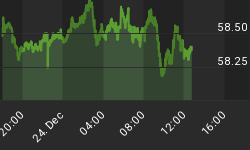Dow Jones Industrial Average 11,220
Value Line Arithmetic Index 1,951
30-Year Treasury Yield(TYX) 5.07%
20+ Year Treasury Bond Price (TLT) 85.70
Gold 1/10 Ounce (GLD) $63.11
The Big Picture for Stocks
The 4-year cycle calls for a bear market bottom in 2006.
Technical Trendicator (1-4 month trend):
Stock Prices Up
Bond Prices Up
Gold Price Up
Thoughts about the Stock Market
I am reasonably comfortable with our buy signal last week. The market got nicely oversold. As an indication of that, Jason Goepfert at www.sentimentrader.com calculated the percentage of stocks above their 10-day moving average, their 50-day moving average, and their 200-day moving average. The average of those three numbers was under 20%. Nine out of nine times in the past when that happened, a significant rally ensued.
I have been suggesting a defensive investment posture for many months now. I still have some concerns. One reason is that the consumer has been the most indebted in history. I suspect that that the long housing boom -- which propped up the consumer but is likely over -- will lead to a serious consumer recession. We may already be in such but the statistical indications of that haven't gotten nearly as bad as they are likely to. And I doubt investors are prepared for an extended period of time when retailers report down earnings. Such a situation will send chills all through our economy. Usually bear markets end when the news is the worst, and the worst is yet to come.
There is another factor that has been working through my psyche. Every generation has had an event that wiped out wealth. My father's generation had the period of 20% interest rates; my grandfather's generation had the Great Depression; and so forth on back in time. In spite of the big bear market from 2000 to 2002, it seems to me that today the super-wealthy class has continued to get much larger. I have a friend who is a broker at Merrill Lynch who only takes customers that have a minimum of $10 million. This seems incredible to me. It was only 6 years ago that I stopped being a broker myself, after being in the business for 28 years. I never had a single customer with assets anywhere near that amount.
If you drive around our home town of Austin, you will see large numbers of enormous mansions. This seems to me to a sign of an economy at risk. To me, it is reminiscent of the opulence you can see at the Newport, Rhode Island, mansions built a hundred or so years ago -- shortly before the crash.
In past generations, few people if any could have predicted the events that destroyed -- or at least shifted -- huge pools of wealth. If there is something around the corner that will hit us hard, we are probably blind to it.
On the Other Hand
The problem with what I just said is that such an unforeseen problem might be a long time off. And we still have to make decisions daily about our own portfolios based on reason and evidence.
Our Special Situations list is oriented mostly toward small speculative stocks that have the potential to increase a lot in value. Historically smallcap stocks have done much better than large companies. We have had some great successes since we started the newsletter, but we have also had some incredible failures. The way to come out ahead when dealing with the huge volatility of small stocks is to have more of these stocks when times are the most favorable, and fewer of them when times are least favorable.
It appears to me that now is a time to be increasing the number of these stocks in one's portfolio -- if you have part of your portfolio that you deem to be suitable for this type of aggressive investing. Many microcap stocks have dropped 50-70% from their highs just this year!
This weekend I have gone through a list of about 100 such stocks that I have not watched very closely in the last few months because I deemed it an inappropriate time to buy them. But now that they are down, there are a number of interesting potential opportunities. I've selected several for your consideration as listed on our site. For Safe Haven readers, we invite you to visit our site. Our site is one of the few on the web that one can get legitimate ideas on microcap stocks. But you could develop your own list of beaten-down microcap stocks.
I like to look for companies that have the potential for rapidly rising revenues, or be significantly undervalued versus standard measures.
















